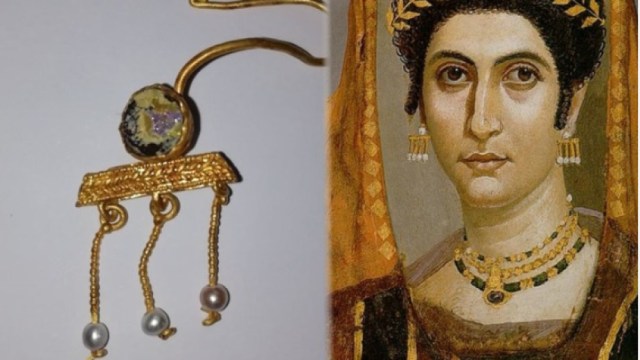Roman Woman’s Trendy Earring Unearthed in Bulgaria
Archaeology in Bulgaria reports that an intact gold earring has been discovered in what was a room of the public bath at Deultum, a Roman colony founded in the first century A.D. by veterans of Augustus’ Eighth Legion near Bulgaria’s Black Sea coast. The artefact matches earrings shown in the second century A.D.
A genuine ancient gold earring that can be used in some of the so-called Fayum Mummy portraits of Roman Egypt was found by archaeologists in south-east Bulgaria excavating the Deultum Ancient Roman colony near the town of Debelt, district Burgas, near the Black Sea coast.
Deultum was a Roman colony, which according to Roman law signified a status equal to that of the city of Rome itself. In today’s Bulgaria, there are only three Roman cities which enjoyed this status – Deultum (Colonia Flavia Pacis Deultensium) near Burgas, Ratiaria (Colonia Ulpia Traiana Ratiaria) near Archar, Ulpia Oescus near Gigen.
Fayum mummy portraits are portraits on wooden boards which were attached to the mummies of upper-class residents buried in Egypt during the Roman Era, in the 1st century BC – 3rd AD.
Such mummy portraits have been discovered throughout Egypt but most famously in the Fayum Basin, in Hawara and the Roman city of Antinoopolis from the time of Emperor Hadrian (r. 117 – 138). The term “Fayum mummy portraits” is used both as a geographic and stylistic description.
The Roman gold earring discovered in the city of Deultum in Southeast Bulgaria has been found to appear exactly the same as earrings of women depicted in some of the Fayum mummy portraits. Based on that similarity, the earring is dated by the Bulgarian researchers to the 2nd century AD.
The Ancient Roman city of Deultum (Colonia Flavia Pacis Deultensium) was built in the 1st century AD near a previously existing Ancient Thracian settlement called Debelt or Develt. It was settled by Roman military veterans from the Augustus’ Eight Legion (Legio VIII Augusta) near the Mandra Lake (today the Mandra Water Reservoir) where it also had a port connecting it to the Black Sea.

The present archaeological excavations in the Deultum – Debelt Archaeological Preserve began on October 1, 2020; the Fayum mummy portrait gold earring was discovered two days later.
The Roman gold earring was found in the joint between tiles in one of the rooms in the ruins of the thermae (public baths) of Deultum, beneath an embankment, informs Krasimira Kostova, head of the Deultum – Debelt Archaeological Preserve, as cited by the Bulgarian National Radio.
“The gold earrings of a noble lady depicted in one of the Fayum Portraits are exactly the same as the earring that we have discovered here in Deultum,” the archaeologist says. She points out that the thermae of Deultum was destroyed in 357 – 358 AD during a major earthquake.
“The gold earring probably was lost as it fell between the tiles, and when the thermae were destroyed by the earthquake, it remained there. Subsequently, the site was levelled with embankments, which is how it remained there. Because the spot of the thermae remained inhabited after that,” Kostova explains.
“This jewel is extremely sophisticated, it is very interesting. We found it has parallels to one of the Fayum mummy portraits, which has led us to date it to the 2nd century AD,” she adds.
“We are construing the discovery of the gold earring like the earrings depicted in that Fayum mummy portrait as evidence that the female inhabitants of the Roman colony of Deultum were following the fashion trends in the Roman Empire, and were up to date with fashion,” the archaeologist emphasizes.
The Fayum portrait gold earring from Deultum – Debelt is fully intact save for a slight bent in its upper part.
It has a cassette filled with white glass with a slight yellowish nuance; below it comes a filigree holder with three pendants, each of which ends with a white glass ball. The patina on the three balls gives them the appearance of pearls.
In addition to the gold earring similar to those in one of the Fayum mummy portraits, the archaeologists excavating the ruins of the Roman city of Deultum have already discovered a large number of bronze coins.
Their digs are now focused on exposing more from the ruins of the thermae (public baths) of the Roman colony. The later homes, which were built on top of the ruins of the Roman thermae in Deulum, were researched during last year’s archaeological season, with the current excavations now targeting the layers beneath.
Once it is fully studied, the gold earring similar to the ones seen a Fayum mummy portrait from Roman Egypt is going to be put on display at the museum of the Deultum – Debelt Archaeological Preserve.





